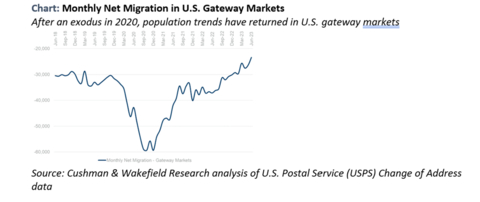The Bright Side of Office: Opportunities in the Urban Core
Demographic shifts, occupier demand, and employment forecasts bode well for the future of the office

1. The population out-migration trends in large cities that accelerated early during the pandemic are returning to long-term norms. (Photo: Business Wire)
“Cushman & Wakefield has not been naïve about the current state and future of office in
Acknowledging those headwinds, this report examines several positive factors that are working in favor of a recovering office market.
-
The population out-migration trends in large cities that accelerated early during the pandemic are returning to long-term norms.
While the pandemic disproportionately impacted urban cores of cities, some of the demographic shifts at the height of the pandemic were temporary. Stated another way, people still want to live in large, vibrant cities.
-
The supply-side boom is quickly unwinding, and new office deliveries will be historically low in the middle of this decade.
Top-tier office product is very much in demand. There is going to be Less new construction will be delivered, however, welcoming opportunities arise for renovated offices and assets slightly further down the value chain.
- Occupiers have been right sizing their portfolios, but much of the effects of increased remote and hybrid work environments have filtered through the system.
Although increased remote and hybrid work is shifting occupier demand, and reducing willingness of employees to commute, but much of that impact has already filtered through the system. Portfolio right-sizing will moderate in coming years. Occupiers are committed to the office as a part of their business strategy, even if they are offering more employee flexibility than they did five years ago. The office is still a central part of the economy and a driver of productivity, career development, culture and innovation.
Office employment declined in the second half of 2023; it is still 1.9 million jobs above its pre-pandemic level. Once it resumes growing, look for occupiers to need more office space for their growing workforces.
“As we adapt and recover, we’re seeing some bright spots for urban office markets,” said Smith. Occupiers and employees are adjusting, supply is adapting, and the economy will create jobs in the coming years.”
Click here to download the full report.
About Cushman & Wakefield
Cushman & Wakefield (NYSE: CWK) is a leading global commercial real estate services firm for property owners and occupiers with approximately 52,000 employees in approximately 400 offices and 60 countries. In 2022, the firm reported revenue of
View source version on businesswire.com: https://www.businesswire.com/news/home/20240131116370/en/
Mike Boonshoft
212-841-7505
Source: Cushman & Wakefield







